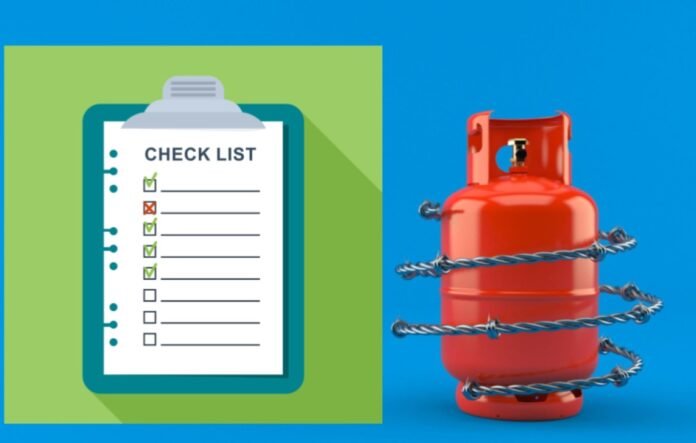Liquid Petroleum Gas (LPG) is a convenient and versatile energy source used for various applications, from cooking to heating. However, safety should always be a top priority when using LPG cylinders or bottles.
Whether you’re a homeowner, a restaurant owner, or someone who relies on LPG for any purpose, following LPG safety tips is essential to prevent accidents and ensure the well-being of everyone around you.
This article will provide you with a comprehensive LPG bottle safety checklist covering everything from storage to handling and maintenance.
LPG Bottle Safety Check List
1. Storage and Placement
Proper storage and placement of LPG bottles are crucial to minimise risks and ensure safety. Here’s what you need to consider:
- Location: Store LPG bottles outdoors in a well-ventilated area. Never store them in basements, garages, or enclosed spaces.
- Distance: Keep LPG bottles safe from ignition sources, such as electrical outlets, open flames, and heat sources.
- Upright Position: Always store LPG bottles upright to prevent gas leakage and potential accidents.
- Ventilation: Ensure the storage area has adequate ventilation to disperse any potential gas leaks.
2. Inspection Before Use
Regularly inspecting your LPG bottles before using them can help identify potential issues before they become hazardous. Follow these steps:
- Check for Damage: Examine the LPG bottle for any signs of damage, such as dents, rust, or corrosion. Damaged bottles can weaken and may leak gas.
- Valve Inspection: Ensure the valve and regulator are correctly attached and in good condition. A damaged valve can lead to gas leaks.
- Hose Examination: If you’re using a hose, check for cracks, brittleness, or signs of wear. Replace the hose if any issues are detected.
- Expiry Date: LPG bottles have an expiry date stamped on them. Make sure you’re using bottles within their validity period.
3. Transporting LPG Bottles
Transporting LPG bottles, whether for refilling or relocation, demands careful attention to safety protocols:
- Securely Fastened: When transporting LPG bottles, ensure they are fastened upright to prevent rolling or tipping.
- Ventilation: If you’re transporting LPG bottles in your vehicle, keep windows partially open for ventilation.
- No Smoking: Absolutely no smoking should occur in the vehicle while transporting LPG bottles.
4. Connection and Disconnection
Connecting and disconnecting LPG bottles require precision to avoid gas leaks:
- No Loose Connections: Ensure all connections are tight and secure. Loose connections can result in gas leaks.
- Soapy Water Test: Apply soapy water to the connections and valves. If you see bubbles forming, it indicates a leak. Address the issue before using the bottle.
- Avoid Force: Never force connections. If a connection is not fitting easily, check for misalignment and address it.
5. Usage Precautions
Using LPG bottles safely during operation is vital:
- Ventilation: Maintain proper ventilation while using LPG appliances indoors to prevent gas accumulation.
- Supervision: Never leave a lit LPG appliance unattended.
- Flame Monitoring: If the flame of an appliance goes out, turn off the gas and wait for a few minutes before relighting it. This allows any accumulated gas to dissipate.
- Keep Flammable Items Away: Keep flammable items like kitchen towels, paper, and curtains away from open flames or hot surfaces.
6. Emergency Preparedness
Being prepared for emergencies is a critical aspect of LPG safety:
- Emergency Numbers: Keep local emergency numbers and the number of your LPG supplier readily available.
- Gas Leak Detection: Learn how to recognise the distinct smell of LPG, which resembles rotten eggs. If you smell gas, turn off the cylinder, leave the area, and call for help.
- Evacuation Plan: Have an evacuation plan for your family or employees in case of a gas leak or fire.
7. Maintenance and Servicing
Regular maintenance of your LPG system ensures its continued safety and efficiency:
- Professional Inspection: Schedule regular inspections by a qualified LPG technician to check for leaks, valve and regulator functionality, and overall system condition.
- Replace Faulty Parts: If any part of the LPG system is found to be faulty during an inspection, promptly replace it with the guidance of a professional.
- Cleaning: Clean the LPG area from dust and debris, which can accumulate and pose fire hazards.
8. Children and LPClean the LPG area Safety
If you have children at home or in your establishment, take extra precautions:
- Childproofing: Store LPG bottles in areas that are inaccessible to children.
- Education: Educate children about the dangers of playing with LPG equipment and the importance of LPG safety.
Conclusion:
LPG is an invaluable resource that simplifies our lives, but safety should never be compromised. Following this comprehensive LPG bottle safety checklist can significantly reduce the risk of accidents, injuries, and property damage.
Remember, regular inspections, proper storage, cautious handling, and emergency preparedness are key to ensuring the safety of everyone around you. Whether you’re a homeowner or a business owner, prioritising LPG safety is a responsibility that cannot be overlooked.
For reliable and safe LPG bottles, contact Plus Gas in Brisbane!

